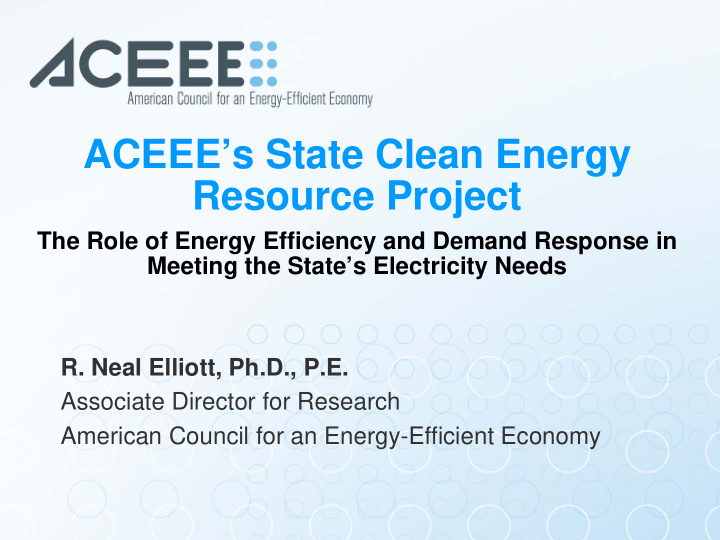



ACEEE’s State Clean Energy Resource Project The Role of Energy Efficiency and Demand Response in Meeting the State’s Electricity Needs R. Neal Elliott, Ph.D., P.E. Associate Director for Research American Council for an Energy-Efficient Economy
The American Council for an Energy- Efficient Economy (ACEEE) Nonprofit 501(c)(3) dedicated to advancing energy efficiency through research and dissemination. 35 staff in Washington, D.C., Illinois, Delaware, Michigan, and Wisconsin Focus on End-Use Efficiency in Industry, Buildings, Utilities, Transportation, & National Policy Offer Conferences and Publications Funding: • Foundation and Federal grants (50%) • Specific Contract work (20%) • Conferences and Publications (25%)
Project Overview ACEEE’s State Project funded by Energy Foundation, U.S. EPA, & U.S. DOE to: – Prepare annual State Policy Scorecard – Prepare 4 state energy efficiency assessments per year – Assist states with ongoing energy policy implementation – Co-Funded by in-state foundations Overall Project Goals: – Build foundation for public education on energy efficiency – Provide key facts with respect to EE opportunities – Inform policymakers on best policy practices
Project Approach State-specific data collection Stakeholder outreach: • State Government • Utilities and Co-ops • Industrial consumers • Public interest groups • Low-income advocates Analysis and report preparation Report release Policy Implementation Assistance
Which States? 2006 ACEEE State EE Scorecard Source: Eldridge 2007
Why Energy Efficiency? The 1 st Fuel Average Cost of New Electric Resources 12 10 Levelized Cost (cents/kWh) 8 6 4 2 - Energy Wind Biomass Nat. Gas Pulverized Thin Film Nuclear Solar Coal IGCC Efficiency Combined Coal PV Thermal (a) Cycle Source: Lazard 2008 except (a) ACEEE 2007
Levels of Energy Efficiency Potential We Analyzed For example: Energy Efficiency Resource Potential in 2025 for VA Cost-Effective without considering Carbon Resource costs • Cost Effective Resource = Policy Achievable ~44,000 GWh (31%) Resource • Policy Analysis = ~28,00 GWh (19%)
Virginia Cost-Effective Energy Efficiency Resource Potential (44,000 GWh or 31% of Projected Electricity Use in 2025) CHP 13% Residential Industrial 32% 12% Commercial 42%
Suite of 11 Policies Analyzed for VA Policies include: • EERS Appliance Efficiency Standards 19% • Mfg Initiative Energy Efficiency • CHP Building Energy Resource Standard Codes (EERS) 10% 51% • Codes & Standards Local • Gov. Facilities Government 4% • Public Education Manufacturering State Combined Heat Initiative Government and Power 10% 2% 5% • RD&D • Demand Response
Impact of Efficiency Policies on Electricity Needs in Virginia 140,000 19% Electricity Consumption (GWh) 120,000 100,000 Appliance Standards Building Codes 80,000 State and Local Government 60,000 Manufacturing Initiative CHP Supporting Policies 40,000 Energy Savings Target 20,000 Adjusted Forecast - 2008 2013 2018 2023
Impact of Efficiency and Demand Response on Peak Demand 2025 peak reduction = ~8400 MW (26%) 35,000 Demand Response 7% 30,000 19% Energy Efficiency 25,000 Peak Demand (MW) 20,000 Adjusted Peak Load 15,000 10,000 5,000 - 7 8 9 0 1 2 3 4 5 6 7 8 9 0 1 2 3 4 5 0 0 0 1 1 1 1 1 1 1 1 1 1 2 2 2 2 2 2 0 0 0 0 0 0 0 0 0 0 0 0 0 0 0 0 0 0 0 2 2 2 2 2 2 2 2 2 2 2 2 2 2 2 2 2 2 2
Impacts of State Clean Energy Studies in Other States • Basis for Gov. Crist’s energy plan in Florida • Supported expanded EEIP and CHP policies in TX • Key contributor to passing of EmPower Maryland legislation • Gov. Kaine intends to us a foundation for Year of Energy
Program Models – Opportunities and Challenges Approaches: • NGO/QGI Administered– e.g., Efficiency Vermont & Energy Trust of Oregon • Government Administered – NYSERDA • Utility Administered • Outsourced delivery – CPUC & Texas Challenges: • Project “ramp” rate • Workforce/infrastructure shortages
Implementation Issues • Role of Codes & Standards – national and state • Interaction between EERS and RPS • New Construction vs. Built Environment • Need to treat Manufacturing & Ag/Rural Differently from Commercial & Residential • Treatment of CHP with respect to avoided fuel/emissions • Role of federal activities: Tax credits • Federal Energy Legislation • National Climate Change Legislation • Expanded EE program budgets •
Role of Energy Efficiency in Climate Change • Quickest, least cost carbon reduction strategy – can meet ~½ in the nearterm • Enables other strategies by providing time and containing costs • Estimation of avoided electric emissions difficult in PJM context – DE net electric importer • Interaction with Federal Legislation
Conclusions • There are plenty of energy efficiency • Investing in efficiency will: • Reduce consumer electric bills • Insure stable & reliable electric system • Promote new jobs & economic growth • Make important contributions to addressing global warming • Many of the opportunities require state-level efforts – one size does not fit all
Contact Information R. Neal Elliott, Ph.D., P.E. Associate Director for Research ACEEE 529 14 th Street, NW, Suite 600 Washington, D.C. 20045 202-507-4009 rnelliott@aceee.org For more information visit: www.aceee.org
Recommend
More recommend